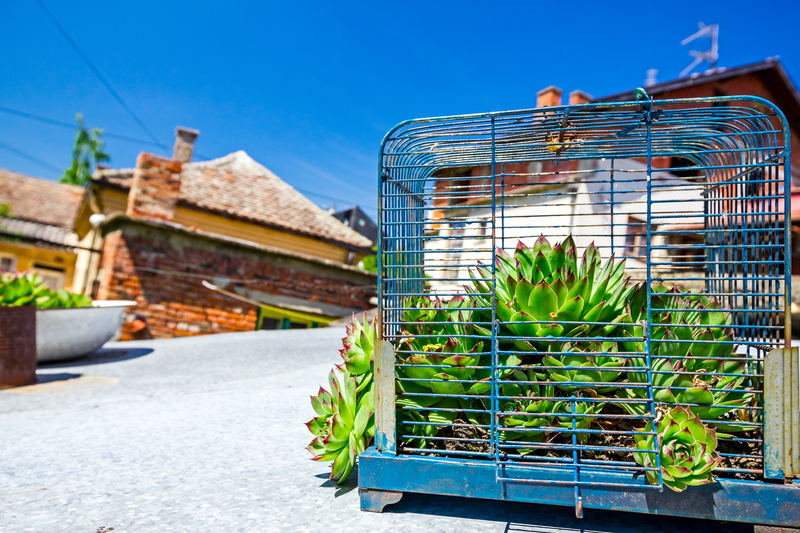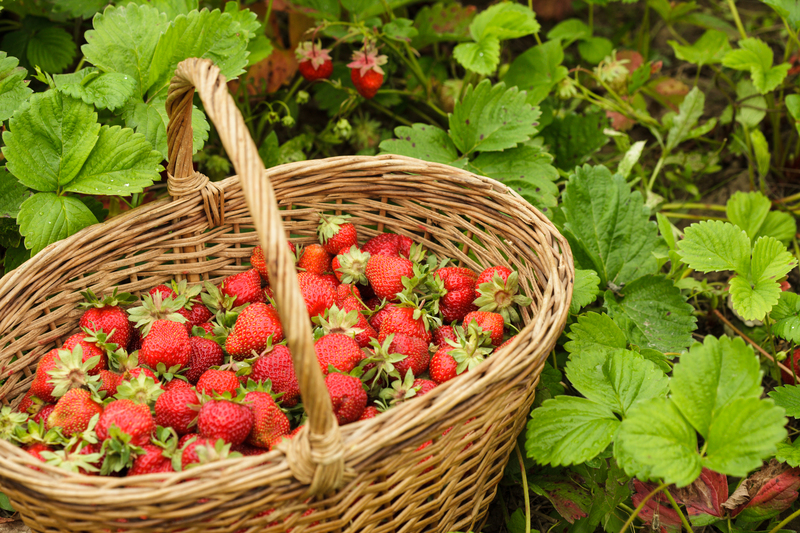Embracing Small Spaces with Container Gardening
Posted on 23/08/2025
Embracing Small Spaces with Container Gardening: A Comprehensive Guide
Urban living and modern lifestyles often limit our access to sprawling gardens, but that doesn't mean we must forgo the joy of growing our own plants. Embracing small spaces with container gardening offers a creative, flexible solution--one that brings nature, color, and even homegrown food right to your doorstep, balcony, windowsill, or patio.
What is Container Gardening?
Container gardening is the art and practice of growing plants in containers--everything from classic clay pots to repurposed buckets, hanging baskets, or vertical wall planters. This style of gardening is perfectly tailored for limited spaces and is a boon for city dwellers, renters, or anyone with a small yard. Whether you're dreaming of vibrant flowers, fresh herbs, or even vegetables, container gardening turns almost any space into a lush, green retreat.

Why Choose Container Gardening for Small Spaces?
Many people mistakenly believe that you need a large yard to become a gardener. Container gardening in small spaces proves otherwise. Here's why this practice is increasingly popular--and accessible:
- Versatility: Grow a wide range of plants--flowers, herbs, veggies, and fruits--in pots suited for any nook or cranny.
- Mobility: Move your containers for optimal sunlight, seasonal changes, or simply for a new look.
- Control: Manage soil type, moisture levels, and even pests more easily than in-ground beds.
- Accessibility: Perfect for beginners, busy families, or anyone with limited mobility.
- Aesthetics: Instantly transform balconies, patios, entryways, or rooftops with colorful, living displays.
Container Gardening Ideas for Small Spaces
There are countless creative ways to maximize greenery in your limited area. Whether you have a balcony, small patio, windowsill, or even just kitchen counter space, here are brilliant ideas to try:
- Vertical Gardens: Use wall-mounted pots, shelves, or pocket planters to go skyward--ideal for herbs and leafy greens.
- Hanging Baskets: Suspend plants from ceilings, awnings, or balcony rails to add greenery without sacrificing floor space.
- Tiered and Stacked Pots: Create levels of foliage using plant stands or stackable containers.
- Rail Planters: Clip herb boxes or flower pots to balcony or window rails for extra growing space.
- Recycled Containers: Upcycle old buckets, tins, or even furniture to craft unique, eco-friendly planters.
Best Plants for Small-Space Container Gardening
The key to successful small-space container gardening lies in choosing the right plants. Consider these criteria:
- Growth Habit: Opt for compact, bushy, or trailing varieties rather than sprawling plants.
- Sunlight Needs: Assess how much sun your chosen space receives and select accordingly (shade-loving, partial sun, or full-sun plants).
- Maintenance: If you're a beginner, start with low-maintenance species.
Top Plant Picks for Compact Containers
- Herbs: Basil, mint, parsley, thyme, cilantro, rosemary
- Leafy Greens: Lettuce, spinach, arugula, Swiss chard
- Dwarf Vegetables: Cherry tomatoes, bush beans, mini peppers, radishes, baby carrots
- Flowers: Petunias, pansies, marigolds, begonias, geraniums, violas
- Succulents: Sedum, echeveria, jade plant, aloe vera
Pro tip: Mix different plant types in a single large container for a lush, layered effect!
Choosing the Right Containers
When it comes to small-space container gardening, not all pots are created equal. The material, size, and drainage are important:
- Material: Plastic is light and affordable; clay and ceramic provide beauty but are heavier. Metal and wood planters offer a rustic feel but may need liners to prevent decay.
- Size: Bigger containers hold more soil and require less frequent watering. However, ensure they fit your available space.
- Drainage: Always select pots with drainage holes to prevent root rot. Use pot saucers indoors to catch excess water.
Smart Container Gardening Tips
- Use lightweight potting mixes for good drainage and easier container mobility.
- Add gravel or broken pottery shards to the bottom to improve drainage.
- Group containers together for a bold display and to make maintenance easier.
- Select self-watering planters if you're often away or want lower-maintenance solutions.
Soil, Watering, and Fertilizing for Container Gardens
Best Soil for Containers
Don't use garden soil--it's too heavy and can cause drainage issues. Instead, choose a high-quality, sterile potting mix. Look for unique mixes tailored for vegetables or flowers for the best results.
Watering Tips for Pot Gardens
Containers dry out faster than garden beds, especially in warm weather. Here's how to keep your plants happy and hydrated:
- Check Moisture Daily: Stick a finger into the soil--water if the top inch feels dry.
- Water Thoroughly: Ensure water runs out the drain holes; don't just wet the surface.
- Mulch: A layer of bark, pebbles, or compost on top helps conserve moisture and reduce weeds.
- Consider Drip Irrigation: Self-watering and drip systems are great for container gardens, especially if you're away frequently.
Fertilizing in Small Spaces
Frequent watering can leach nutrients from the soil. Feed container plants with a balanced, slow-release granular fertilizer or a soluble liquid feed every 4-6 weeks during the growing season. Always follow the product's instructions to avoid over-fertilizing.
Creative Space-Saving Container Garden Designs
Kickstart your creativity with these inspiring small space container gardening ideas:
- Herb Towers: Stack several small pots vertically, growing a different herb in each tier--a fragrant and space-saving solution for kitchens or patios.
- Hanging Vegetable Planters: Grow dwarf tomatoes, strawberries, or peppers in upside-down or pocket planters suspended along balcony rails.
- Window Box Edible Gardens: Sow a mixture of salad greens, chives, and microgreens in window boxes for a healthy harvest right outside your window.
- Pallet Gardens: Upcycle wooden pallets laid vertically, filling the slats with compact annuals or culinary herbs.
- Mobile Gardens: Place larger containers on rolling plant caddies so you can chase the sun or reconfigure your space as needed.
Combine Function and Style
Your containers aren't just functional; they're decorative, too. Choose pots that complement your design style--classic terracotta, modern minimalist, or colorful mismatched themes. Add garden art, fairy lights, or trellises for height and visual drama.
Solving Common Challenges in Container Gardening
Pest & Disease Management
- Inspect plants regularly for aphids, spider mites, or fungal spots.
- Remove infected leaves and, if necessary, treat with insecticidal soap or neem oil.
- Avoid overcrowding, which can invite disease by limiting air circulation.
Overcoming Environmental Challenges
- Wind: Shield delicate plants with screens or group larger pots as natural windbreaks.
- Intense Sun: Use shade cloth or move containers during the hottest part of the day if possible.
- Temperature Fluctuations: Bring containers indoors during cold snaps or sudden storms.
How to Start Your Own Small-Space Container Garden
Step-by-Step Guide for Beginners
- Assess Your Sun Exposure: Is your intended space full sun, part shade, or mostly shaded?
- Define Your Goals: Are you after culinary herbs, fresh produce, flowers, or a combination?
- Pick Your Containers: Select sizes and styles that fit your space and plants of choice.
- Choose Your Plants: Refer to the lists above for the best compact and container-suited varieties.
- Fill with Potting Mix: Use premium potting soil for healthy plant growth.
- Plant and Arrange: Place taller plants in the center or back, trailing plants on the edges, and fillers in between.
- Add Mulch or Decorative Stones: Top dress to enhance visual appeal and water retention.
- Establish a Care Routine: Water as needed, feed monthly, and trim back as plants grow.

Benefits of Embracing Small-Scale Container Gardening
More than a trend, embracing small spaces with container gardening unlocks a range of emotional, practical, and environmental benefits:
- Stress Reduction: Tending plants promotes mental well-being and calmness.
- Year-Round Growth: Move containers indoors in winter, extending your growing season.
- Fresh Food Access: Grow salads, herbs, and some veggies within arm's reach, even in city apartments.
- Biodiversity: Attract pollinators such as bees and butterflies--even in urban environments.
- Sense of Accomplishment: Watch seeds sprout, flowers bloom, or harvest your own herbs--a rewarding hobby for all ages.
Final Thoughts: Your Green Oasis Awaits
Whether you have a sprawling backyard or a single sunny windowsill, you can create an inviting, productive green space. Container gardening in small spaces is not just about fitting plants where you can--it's about transforming your environment and reconnecting with nature, no matter how modest your square footage.
Ready to get started? Grab a pot, choose your favorite plant, and you'll soon see: with a little creativity, any area can flourish into a personal oasis. Embrace the possibilities--your perfect garden could be just a container away!

